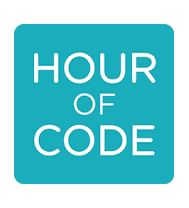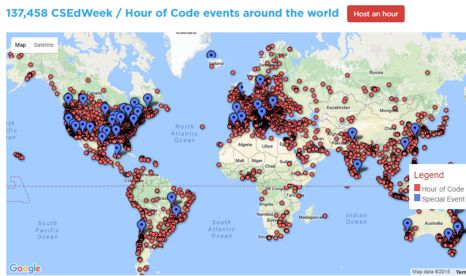| Resources for Hour of Code |
| Written by Sue Gee | |||
| Monday, 05 December 2016 | |||
|
For the 2021 Hour of Code see Computer Science Everywhere Computer Science Education Week starts today, December 5th, 2016. Between now and December 11th events to bring code into schools are planned across the world. There are now tens, if not hundreds of pre-packaged resources with something to suit every classroom and each individual. Here we consider at just a few, after a look at what CSEd week/Code.org has already achieved. CSEd Week was initiated in the United States in 2010 to focus on the need to build strong computer science education programs in schools to address a perceived shortfall in the number of individuals with appropriate skills for a technology-dominated future. The timing of the early December was chosen to coincide with the birthday of Grace Hopper (December 9th, 1906), which accounts in some part for the emphasis on involving girls in Computer Science. The Hour of Code, which now dominates CSEd Week, entered this campaign in 2013 with backing from high profile personalities in sport and entertainment as well as from the computer industry. Within three years Code.org has succeeded in most of its aims. Not only have more than 300 million Hour of Codes been served online, there is now greater recognition that learning to program helps with problem solving, logic and creativity. There has been an upturn in students enrolling in Computer Science at undergraduate level and record numbers of girls have been introduced to coding. At the present time Computer Science is doing well at making inroads into education in the United States. We recently reported on the K-12 Computer Science Framework drawn up by Code.org and partners including the Association for Computing Machinery (ACM), Computer Science Teachers Association, in collaboration with states, districts, and the computer science education community. The Obama administration helped a lot towards improving the standing of CS with the “Computer Science for All” initiative, includes $4 billion in funding for states and $100 million directly for districts to increase access to K-12 computer science education by training teachers and expanding access to instructional materials. While there is arguably less need for an Hour of Code in 2016, it has become an established part of the school calendar. The obvious starting point for anyone new to the idea is the Hour of Code website which has a guide entitled How to teach one Hour of Code as well as 172 activities. These can be sorted by age going from Pre-reader, through Grades 2-5 and Grades 6-8 to Grade 9+. Other filters are Educator experience and Student experience with two options Beginner and Comfortable. Classroom Technology, Topics and Length are other options. Microsoft's Minecraft Hour of Code, which targets Grades 2 and upwards, i.e all users who can read, and is suitable for beginners, both teachers and pupils, comes top of the list by popularity. Like many of the Hour of Code tutorials it uses drag and drop blocks of code. It features Steve and Alex from Minecraft and involves exploring a 2D world with these two characters, encountering Minecraft-inspired challenges along the way. There are 14 puzzles to work through, maneuvering Steve and Alex through increasingly complex tasks such as moving through the world, shearing sheep, chopping down trees, and building houses. When you've put together the blocks to complete a puzzle, you can reveal the JavaScript code behind the blocks. A third Disney Hour of Code has been added to the list - Moana: Wayfinding with Code and like its two predecessors, Frozen and Star Wars, it is based on a recently released animated movies and is designed to appeal to girls. While Disney gets involved with Code just for the Hour of Code Tynker, which has 30 coding activities that are freely available for CSEdWeek, offers coding and Minecraft modding for kids aged 7 and up with self-paced courses available on a subscription basis. This means that if an Hour of Code succeeds in sparking a love of coding there is plenty more on offer. Tynker is used by more than 50,000 schools and 35 million students in over 200 countries and has courses in JavaScript and Python that are suitable for students who are already at the "Comfortable" level of experience, Krishna Vedati, CEO of Tynker explains: “We want to turn your students’ passion for playing video games, crafting with Minecraft, and playing with toys into valuable life skills. We have designed this year’s activities to spark a deeper interest in STEM subjects, computer programming, and engineering.” If you are looking for an Hour of Code with a follow-on path take a look at Hello Processing, one of the original Hour of Code tutorials which has the aim of providing: an introduction to computer programming within the context of visual media in a way that encourages future exploration and creates enthusiasm for coding. The hour-long tutorial is taught by Dan Shiffman who also presents The Nature of Code which is a 5-session (10 week) course on the Kadenze Platform. For students who are looking to learn a programming language with the aim of going further there are plenty of options. One that could well fit into an Hour of Code experience is Snakify, an interactive Python 3 tutorial with over 100 exercises with lessons that start from scratch but quickly go deeper. It offers challenging problems and has a visualizer that means you can step back and forth through program execution to see the variables.
More InformationComputer Science Education Week Related ArticlesHour Of Code Aims To Reach 10 Million Students
To be informed about new articles on I Programmer, sign up for our weekly newsletter, subscribe to the RSS feed and follow us on Twitter, Facebook or Linkedin.
Comments
or email your comment to: comments@i-programmer.info |
|||
| Last Updated ( Saturday, 13 November 2021 ) |



